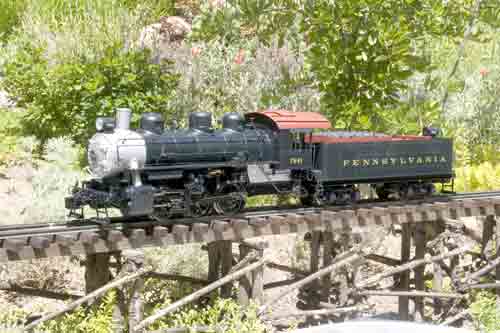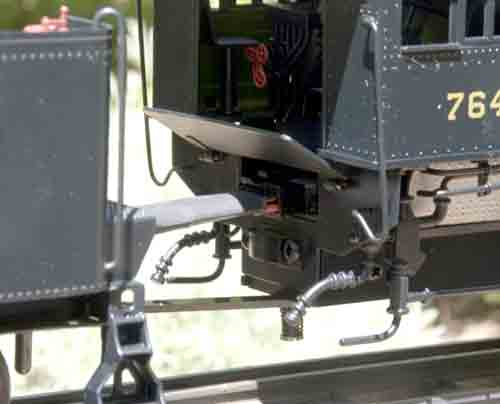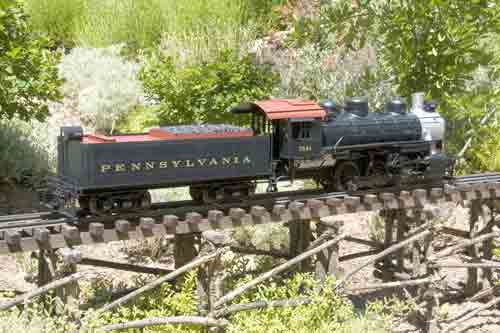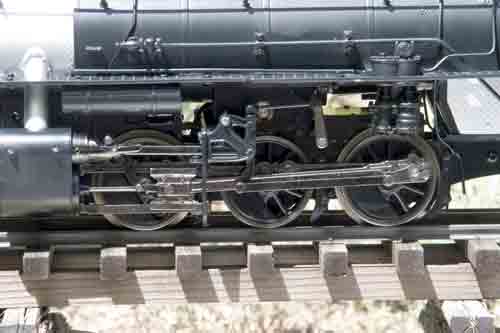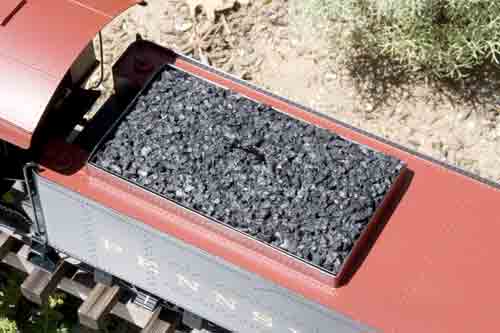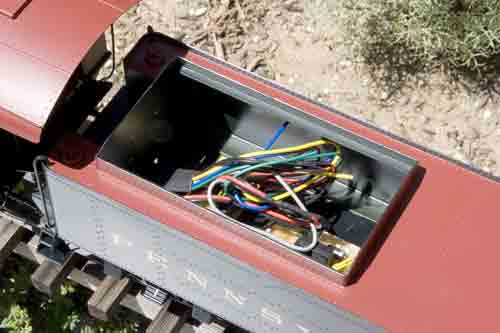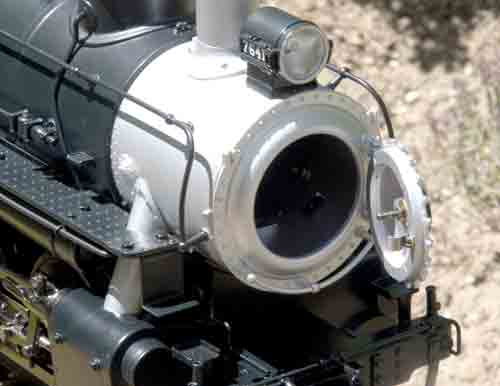Gauge 1, 1:29 scale, electrically powered, USRA 0-6-0
American Mainline
33268 Central Ave.
Union City CA 94587
Price: $1,599
E-mail: americanmainline@gmail.com
Web site: http://americanmainline.com
Electrically powered model of USRA 0-6-0 switcher; made of brass, steel, and die castings; 24V gear-head motor; electronics in tender; 12 pickup wheels; directional lighting; sound-system ready; working knuckled couplers; minimum radius, 30″; variety of road names available; instruction manual included. Dimensions: length (locomotive and tender), 30″; width, 4¼”; height, 6″. In 1:29 scale this works out to 72’6″ x 10’3″ x 14’6″, respectively. Tractive effort at full slip, 1 lb. 14 oz, or around 24 average freight cars on straight, level track
Pros: Sturdy, well-made model; high level of detail; high fidelity to prototype; excellent paint and graphics; variety of road names available; easy access to electronics; good operating characteristics
Cons: Fair amount of resistance in tender pickup wheels
The 0-6-0 was the smallest of these engines. After the war, the USRA locomotives were absorbed into around 97 US railroads. The USRA designs were so successful that they continued to be produced even after the war was over.
The yard switcher is perhaps the most unglamorous of all steam locomotives. However, it was an integral part of the workings of all major and many minor railroads up until the end of steam. Hundreds of them were built, including the 225 war-time USRA engines built by Baldwin and Alco. These engines shuffled cars around the yards, made up trains, dragged dead steamers to and from the shops, and did countless other thankless chores. American Mainline’s model is a replica of these engines.
The model is an accurate portrayal of the prototype and captures its character well. It is made entirely of metal. The middle axle is powered by the motor and the other two by the side rods. The third axle has a “chuff” cam for a sound system (not included). There are four contacts on the cam, to provide the correct number of chuffs per revolution of the drivers.
There is a headlight on the locomotive and another on the tender. These are directional. The cab is also lit. Locomotive and tender are fitted with body mounted, working knuckle couplers. These swing from side to side and have lateral springs to keep them centered. Both locomotive and tender have the over-deep wheel flanges we have come to expect on 1:29-scale equipment.
The detail level is very high, yet the engine does not feel fragile. You do have to be careful of some of the obvious details, though, like the bell and whistle. The engine is available in several different road names, and the details may or may not match the particular road’s prototype. Road names include Union Pacific, Pennsylvania (reviewed), Central of New Jersey, Burlington, Canadian National, Baltimore & Ohio, and more.
Electricity is picked from 12 points-four drivers and all eight of the tender’s wheels. The electrical pickups are spring-loaded plungers that bear on the back sides of the wheels. These create a fair amount of drag in the tender, preventing it from rolling as smoothly as it might.
All power is routed to a circuit board in the tender, that is easily accessed through the lift-off coal load. For operation, the locomotive must be plugged into the tender via a 12-pin connector beneath the footplate. A circuit diagram is provided in the instruction manual. However, this appears to be a sort of generic diagram, as there are things on it (smoke unit, marker lights) that this engine does not posses. The engine is sound-ready, with speaker holes already in place in the bottom of the tender. Color-coded wires in the tender are ready to be hooked up to after-market sound systems, as per the circuit drawing.
The engine runs smoothly and quietly. It has enough tractive effort for around two dozen cars. This is not bad, but it might be possible for the tractive effort to be increased by the addition of weight inside the boiler, as the smokebox door opens and the boiler shell appears hollow. Slow-speed operation is excellent; however, the engine’s top-end speed, at 24V, far exceeds what the prototype might be expected to do. Since the engine is easily controllable at its low end, this is not a particular issue.
Locomotives of this type could be seen virtually everywhere in the heyday of steam. AML’s fine model would certainly be right at home on any 1:29 scale, steam- or transition-era railroad.





